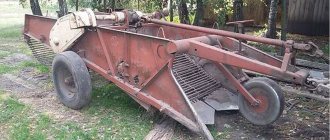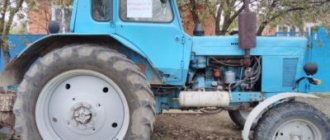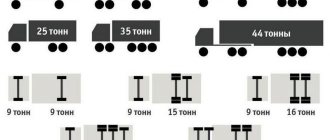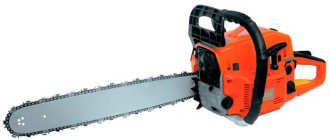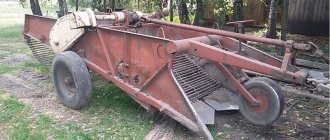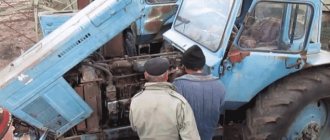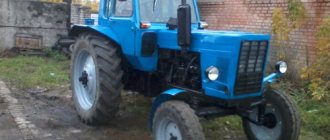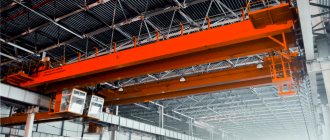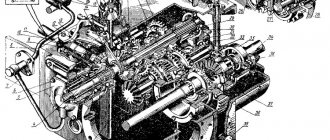On July 1, 1994, traffic rules were put into effect, approved by the Decree of the Government of the Russian Federation No. 1090 of October 23, 1993 “On the Rules...” (hereinafter referred to as the Rules).
Dear readers! The article talks about typical ways to resolve legal issues, but each case is individual. If you want to find out how to solve your particular problem , contact a consultant:
+7 (499) 938-81-90 (Moscow)
+7 (812) 467-32-77 (Saint Petersburg)
8 (800) 301-79-36 (Regions)
APPLICATIONS AND CALLS ARE ACCEPTED 24/7 and 7 days a week.
It's fast and FREE !
The rules are mandatory for compliance throughout the entire territory of the Russian Federation by all persons who in one way or another take part in transport traffic (clause 1.1 of the Rules). Self-propelled (hereinafter also referred to as self-propelled) vehicles are fully covered by the Rules.
Which vehicles are
In clause 1.2. The rules do not introduce such a concept as “self-propelled machine” or “self-propelled equipment”.
But it is said that any tractors and self-propelled machines belong to mechanical vehicles - that is, to those vehicles that are driven by an engine. Accordingly, self-propelled vehicles are subject to the rules of the Rules that apply to other mechanical vehicles.
A clear definition of the concept of “self-propelled machine” is presented in two regulations:
- in clause 2 of the Admission Rules..., approved by Government Decree No. 796 of July 12, 1999 “On approval...” (hereinafter referred to as the Regulations);
- and in ab. 2 clause 1 of the Rules for conducting..., approved by Government Decree No. 1013 of November 13, 2013 “On technical...”.
The most complete definition is given in the Regulations: self-propelled equipment is tractors, road construction units and other trackless mechanical vehicles with an internal combustion engine of more than 50 cubic meters, or an electric motor with a power of more than 4 kW.
Right there, in the Regulations, it is said that self-propelled vehicles are not considered to be vehicles for the registration of which the territorial bodies of the State Traffic Safety Inspectorate are responsible - namely, the vehicles specified in paragraph 1 of the Rules for the registration of motor vehicles ... approved by Order of the Ministry of Internal Affairs No. 1001 of November 24, 2008 “On ok...”
It is important to know that the registration of self-propelled vehicles in the Russian Federation is carried out not by the State Traffic Safety Inspectorate, but by the territorial divisions of Gostekhnadzor (see paragraph 3, paragraph 2 of Government Decree No. 938 of August 12, 1994 “On State ...”).
Registration by Gostekhnadzor bodies is carried out in accordance with the State Rules ... approved on January 16, 1995 by V. N. Shcherbak.
Is the right to a tractor deprived if the right to a car is deprived?
After a court decision to deprive a driver’s license, a person must stop driving all other vehicles, which include self-propelled utility vehicles. According to the new legislation, the driver loses his permit:
- drive any vehicle whose engine capacity exceeds 50 cm3;
- drive vehicles whose maximum speed is above 50 km/h;
- tow trailers that are subject to mandatory state registration;
- drive category “C” vehicles;
- be behind the wheel while trolleybuses, trams and other cars are moving.
Violation of one of these points for the first time after deprivation of rights threatens a person with a large fine or confiscation of moving property. Repeated violations can result in lifelong driver's license suspension and even actual prison time.
What category of driver's license is needed?
You will only need to obtain a driver's license for a self-propelled vehicle if the engine capacity of the self-propelled vehicle, in accordance with the passport, is more than 50 cubic meters (for an internal combustion engine) or more than 4 kW (if the machine is equipped with an electric motor).
The right to operate equipment with the above characteristics is confirmed by one of 2 documents (clause 3 of the Regulations):
- or a tractor driver’s license;
- or a temporary certificate.
In accordance with clause 4 of the Regulations, there are 6 main categories:
| Category specified in the tractor driver's license | Subcategory | What self-propelled vehicles can be operated in this category after completing training and passing exams? |
| A | A1 | Motorcycle SUVs |
| A2 | SUVs with a number of seats not exceeding 8 and a weight not exceeding 3500 kg | |
| A3 | SUVs weighing over 3500 kg | |
| A4 | SUVs with more than 8 seats and specially designed for transporting passengers | |
| B | Self-propelled vehicles on wheels or tracks with a power of no more than 25.7 kW | |
| C | Self-propelled wheeled vehicles with engines from 25.7 to 110.3 kW | |
| D | Wheeled from 110.3 kW and more | |
| E | Crawler from 25.7 kW and more | |
| F | Self-propelled, designed for agricultural work |
Based on clause 10 of the Regulations, in order to receive the appropriate category, a citizen is required to pass an exam. Admission to the exam is subject to compliance with the requirements presented in clause 11 of the Regulations.
What does the law say?
In the countries of the post-Soviet space, people are still very attached to agriculture. Various types of equipment are increasingly being acquired here, greatly facilitating human labor. That is why questions regarding the registration of such units and obtaining a license to drive them have become relevant.
It is worth noting right away that a walk-behind tractor with a trailer is not a vehicle. Therefore, there is no need to register such cars. There is no mention of walk-behind tractors in the PPD, therefore, there are no rules for managing them either. That is, you do not need to obtain a driving license either in Ukraine or in Russia.
On the Internet you can find a lot of information about how law enforcement officers on the roads neglect the law and their powers, fining owners of agricultural equipment who drove onto the road. To avoid problems, you should still have a category A license - permission to drive a motorcycle.
If you are the owner of a mini tractor converted into a walk-behind tractor, then there are already some difficulties here. It is still not a vehicle, but at the same time it can well be considered a self-propelled agricultural machinery. You may have to register it with Rostekhnadzor (for Russia), Gostekhnadzor (for Ukraine). This procedure also includes an examination to determine the compliance of the equipment with generally accepted standards. You'll have to pay for it.
In Ukraine, until recently, it was not possible to register mini tractors with an engine capacity of no more than 50 cubic meters. But today this rule no longer applies. If you drive this unit between fields, then this road is not controlled by traffic inspectors, therefore no one will issue you a fine. If special equipment needs to be transported around the city, then it must be placed in a special trailer.
It is also worth noting that it is the traffic inspectorate in Russia and Ukraine that is responsible for everything that moves on the roads, even if you registered the equipment with Rostekhnadzor or Gostekhnadzor.
Where traffic is prohibited
The Rules indicate only one case when the movement of self-propelled vehicles is prohibited without alternative.
In particular, ab. 2 clause 16.1. The rules state that the movement of pedestrians, pets, cyclists, moped riders, tractors and other self-propelled vehicles is prohibited on highways.
In addition, on the highway marked with sign 5.1., you cannot drive any vehicle at all, the technical characteristics of which do not allow a speed of over 40 km/h.
There is also a ban that applies only to tractors and self-propelled vehicles with tracks. This prohibition is contained in art. 4 clause 12 of the Basic Provisions for Admission.
It says that tractors and self-propelled equipment on tracks cannot move on roads that have:
- asphalt;
- or cement-concrete coating.
In other cases, this or that ban on driving on a certain road for self-propelled vehicles is introduced by an appropriate sign (details below).
The features of turning left and making a U-turn according to traffic rules are discussed in the article: turning around under traffic rules. Read the definition of emergency braking in the traffic rules here.
What signs correspond
A tractor driver operating a self-propelled vehicle must follow the requirements of all road signs listed in Appendix 1 to the Rules.
All warnings and priority signs apply to drivers of motor vehicles without any exceptions.
In other words, the driver of a tractor, just like drivers of cars, must stop at a red traffic light or give way to vehicles moving on the main road.
Among the prohibition signs there are signs that:
- extend their effect to all mechanical vehicles, including self-propelled ones;
- do not apply to self-propelled vehicles;
- or extend their effect specifically to self-propelled vehicles.
Group 1 includes such indicators as, for example:
- 1., prohibiting the entry of all vehicles;
- 2., introducing a ban on the movement of all vehicles;
- 3., regulating the ban on the movement of only mechanical vehicles (including self-propelled ones);
- 4., stating the impossibility of movement for trucks weighing over 3.5 tons, tractors and self-propelled vehicles.
Group 2 includes:
- 5.;
- 8.;
- 9.;
The 3rd group includes an indicator such as 3.6. “Movement of tractors is prohibited” - the sign prohibits driving not only for tractors, but also for other self-propelled vehicles.
The requirements of the mandatory signs apply to the driver of self-propelled vehicles in full.
As for the signs of special regulations, among them the driver of self-propelled vehicles needs to pay attention to the following:
- 2. - indicates the end of the highway and the emergence of opportunities for tractor traffic;
- 3. – only motorcycles, buses and cars are allowed to move; tractors and other self-propelled vehicles are not allowed to move under this sign;
- 36. – means the beginning of the environmental class restriction zone, that is, if the tractor’s environmental class according to the passport is less than that indicated on the sign, movement is prohibited.
Among the information signs, the tractor driver should pay special attention to 6.15.1. – 6.15.3., which regulate the recommended direction for driving, if at an intersection movement in one of the directions is prohibited for such equipment.
Is a tractor a vehicle?
To find out whether state traffic rules apply to a tractor, you need to understand whether an agricultural machine is considered a vehicle. The latest edition of the issued traffic rules clearly states the definition of tractors. According to them, an economic unit can be considered a vehicle. Like other self-propelled mechanisms and machines, utility tractors legally belong to the group of mechanical vehicles.
Since an agricultural machine belongs to the list of vehicles, accordingly, traffic rules for a tractor apply in full. Thus, knowledge of the accepted rules for driving on public roads is mandatory for all people driving tractors while traveling on these roads.
Travel speed
The speed limits that drivers are required to observe on Russian roads are regulated by Section 10 of the Rules and depend on the type of vehicle and the type of road.
Based on clause 10.2. Rules, in populated areas there is a single rule for everyone - you need to move at a speed of no more than 60 km/h. A different speed limit may be set by sign 3.24.
The maximum permitted speed outside the boundaries of a populated area will depend on the weight of the self-propelled vehicle and the type of road on which it is moving:
| No more than 90 km/h | If the mass is less than 3500 kg (paragraph 2 of clause 10.3 of the Rules) |
| No more than 70 km/h | If the mass is more than 3500 kg (paragraph 4 of clause 10.3 of the Rules) |
If self-propelled equipment transports large, dangerous or heavy cargo, regardless of where it is moving - in the city or outside it, you cannot move at a speed higher than that established when agreeing on the terms of transportation (paragraph 2 of clause 10.4 of the Rules) .
In addition, the driver of a tractor or other self-propelled machine is prohibited from:
- exceed the speed determined by the technical capabilities of the vehicle (paragraph 2 of clause 10.5 of the Rules);
- exceed the speed shown on the “Speed Limit” identification sign installed on the rear side of the body in accordance with the requirements of clause 8 of the Basic Provisions for Admission...;
- drive at a speed that does not allow for safe driving due to difficult weather conditions, traffic intensity or visibility (clause 10.1 of the Rules).
Driver is a person who drives a vehicle.
Advantage - the right to priority movement in the intended direction in relation to other road users.
Give way (do not interfere) is a requirement that means that a road user must not resume or continue driving or perform any maneuver if this may force another road user to change direction or speed.
Stopping is a deliberate cessation of the movement of a vehicle for up to 5 minutes, as well as longer if this is necessary for boarding or disembarking passengers or for unloading or loading the vehicle.
Parking is a cessation of movement of a vehicle for a period of more than 5 minutes, unless this is related to the embarkation or disembarkation of passengers or the unloading or loading of the vehicle.
Forced stop - cessation of movement of a vehicle due to its technical malfunction or danger created by the cargo being transported or the condition of the driver.
Overtaking is an advance of one or more vehicles associated with entering the lane (side of the roadway) of oncoming traffic and subsequent return to the previously occupied lane (side of the roadway).
General duties of drivers
Before leaving, the tractor driver is obliged to check the serviceability and completeness of his machine, as well as the availability of fuel, oil and coolant. He must have with him a certificate for the right to drive a tractor, a registration document for the tractor, a waybill of the appropriate sample and a document for the transported cargo.
The waybill and registration document should be presented at the request of engineer-inspectors of Gosseltekhnadzor, police officers, freelance inspectors, military traffic inspectors, military personnel and railway crossing workers.
Operating tractors without a technical certificate is prohibited.
A tractor driver going out for field or reclamation work on the territory of his collective or state farm must have with him a formal work order, which indicates the area of work.
When transporting any cargo, the driver is issued a consignment note or a document replacing it.
The tractor driver does not have the right to transfer control of the tractor to anyone, even to persons who have the right to drive tractors, if their names are not indicated on the waybill or work order.
When a tractor moves in a column during daylight hours, the low beam headlights must be turned on. If a tractor driver is involved in a road accident, then he is obliged to immediately stop his tractor (regardless of whose fault the accident occurred and what its results are), turn on the hazard warning lights, and if there are none, put up an emergency stop sign and do not move the tractor and other items related to the incident. Next, he is obliged to provide assistance to the victims, report the incident to the nearest police officer and wait for the arrival of police officers or investigative agencies and only after their permission to continue moving, and if this is not possible, then take measures to deliver the tractor to the base.
It is completely unacceptable to leave the scene of an accident without providing assistance to the victims and without finding out the cause in the prescribed manner.
Road and road markings
A road is any road, street, alley, etc. used for traffic across its entire width (including sidewalks, curbs and medians). It consists of three main elements: the roadway, shoulders and ditches. For the construction of a country road, a strip called a right-of-way is allocated.
The carriageway is the part of the road intended for the movement of vehicles. A road may have several carriageways, the boundaries of which are dividing strips. The tram track is considered the boundary of the roadway intended for the movement of trackless vehicles.
Traffic lane - any longitudinal strip of a three-way part, designated or not marked by markings and having a width sufficient for the movement of motor vehicles in one row.
A highway is a complex and very expensive engineering structure, therefore all road users, and especially tractor drivers driving very heavy vehicles, often traveling with a wide variety of trailers, must exercise great caution, trying in no way to damage the road surface, as well as the shoulders and ditches located along the edges of the road.
Rice. 112. Horizontal road markings: a, b, c and d - options.
In order to improve the organization of traffic on highways, horizontal and vertical markings are used - lines and inscriptions and other markings applied on the roadway, curbs and other elements of roads and road structures (bridges, tunnels, etc.).
The markings are carried out with paints, as well as thermoplastic masses of white color, except for three lines of yellow color: 1.4; 1.10; 1.17.
Horizontal markings are carried out with various lines, designated in the standard by numbers from 1.1 to 1.23 (where 1 is the horizontal marking, and the second number after the dot means the serial number of the marking in the group).
Among the marking lines used, consider the following.
A narrow solid line 1.1 (Fig. 112, a) separates traffic flows in opposite directions, marks the boundaries of traffic lanes in dangerous places on the roads, etc.
It is prohibited to cross this line, except when line 1.1 marks the edge of the carriageway.
A narrow broken line 1.5 serves to separate traffic flows; crossing such a line is allowed from any side.
The narrow broken line 1.6 indicates an approach to the solid line 1.1. Crossing this line is allowed on both sides.
Two parallel narrow lines, one of which is solid, the other is broken 1.11 (Fig. 112.6), serve to separate traffic flows in opposite directions and designate lanes in the same direction. It is allowed to cross these lines only from the side of the broken line.
Double solid line 1.3 (Fig. 112, c) separates traffic flows in opposite directions with four lanes or multi-lane traffic in both directions; It is prohibited to cross the markings.
A narrow yellow line 1.4 indicates that stopping is prohibited at this location.
Transverse solid line 1.12 (Fig. 112, d) indicates the place where vehicles stop - the stop line in front of the intersection.
Indicator arrows 1.18 show the direction of movement along the lanes.
Vertical markings indicate the surfaces of road structures: bridge supports, the lower edge of the superstructure of bridges and overpasses, round bollards, signal posts, side surfaces of road fences on small radius curves, side surfaces of road fences in other areas, etc.
Vertical markings are applied in stripes of black and white. Many markings on sections of roads that do not have artificial lighting are supplemented with reflective materials and retroreflectors.
There are cases when the meaning of marking lines contradicts the road signs installed in this place. In this case, the tractor driver must follow the instructions of the road sign.
Road signs
Road signs are the most common and fairly effective means of organizing traffic.
All road signs are divided into seven groups: warning; priority; prohibiting; prescriptive; informational and indicative; service; additional information (plates). All signs are assigned a corresponding number. It consists of the group number, the serial number of the character in the group, the serial number of the variety (if any), separated by dots.
Each group of signs differs in shape, color, size and designation.
To make signs visible at night, internal lighting, as well as reflective and luminescent Devices, are used.
The tractor driver must know the meaning of all road signs. Below is a brief description of each group of signs that are most important for tractor drivers from the point of view of ensuring traffic safety.
Warning signs are designed to alert drivers to dangerous places along the road.
This group includes 43 signs, predominantly triangular in shape with a red border and a yellow or white field on which the sign symbol is depicted in black.
Warning signs are installed in front of dangerous sections of the road, outside populated areas 150...300 m, and in populated areas - 50...100 m. A number of signs outside populated areas, such as 1.1; 1.2; 1.9; 1.10; 1.21 and 1.23 are repeated. The second sign is placed at a distance of at least 50 m from the beginning of the dangerous section.
In some cases, signs may be located at other distances from the dangerous section of the road, then this distance is indicated on a sign mounted under the sign.
Let's consider what the tractor driver's procedure should be when encountering some warning signs in order to ensure traffic safety.
Rice. 113. Application of warning signs: a, b. c and d - options.
1.6. “Intersection of equivalent roads” (Fig. 113, a). This sign warns the driver that there is an intersection with an equivalent road ahead.
When approaching such an intersection, the tractor driver must slow down, be prepared to immediately stop his tractor if movement through the intersection is difficult for any reason, give way to vehicles approaching from the right (clause 15.2 of the “Road Rules”), and only after that drive through the intersection in the right direction.
1.13. “Steep descent” (Fig. 113, b) - the sign informs the driver that there is a descent ahead with a slope, the value of which is indicated on the sign as a percentage, for example 10%.
On a steep descent it is much more difficult to stop the tractor than on a horizontal section of the road, since the force of gravity of the tractor increases its braking distance. On a road slope, in front of which there is a sign 1.13, where oncoming passing is difficult, the driver of a tractor moving downhill (on a descent) must give way to a vehicle moving uphill.
On a descent, the tractor driver is obliged to drive his tractor in a low gear with a reduced fuel supply and, as accurately as possible, along the right side of the roadway.
1.14. “Steep climb” (Fig. 113, b) - the sign warns the tractor driver that he must drive his tractor on the climb, as a rule, without stopping, for which, at the beginning of the climb, he should select one of the lower gears, which would ensure performing such a movement. And in case of stopping, the tractor driver must hold the tractor in this position with the brakes, without rolling back.
1.2. “Railway crossing without a barrier” (Fig. 113, c). Railroad crossings are especially dangerous because they can cause collisions with trains. For a more reliable warning to vehicle drivers outside populated areas, sign 1.2 is duplicated, i.e. install two signs. In addition, in addition to them, signs 1.4.3 and 1.4.1 are placed under signs 1.2 and in the middle between them sign 1.4.2.
1.18.1 “Narrowing of the road.” This sign warns vehicle drivers that the roadway ahead is narrowed (exit onto a bridge, road repairs, etc.). On such a section of the road, the tractor driver must be especially careful, reduce the speed and correctly drive through the narrowed place.
1.19. “Two-way traffic” (Fig. 113, d) - the sign shows a section of the road (roadway) with oncoming traffic, which was preceded by a section of the road (roadway) with one-way traffic.
The tractor driver must significantly reduce speed and keep his tractor closer to the edge of the road to clear the way for oncoming traffic.
Priority signs are used to establish the order of passage through intersections or narrow sections of roads where simultaneous traffic in both directions is impossible. This group includes nine signs of different shapes and colors.
Rice. 114. Application of priority signs: a, b, c and d - options.
Priority signs are placed: 2.1 and 2.2, respectively, at the beginning and end of the main road. Sign 2.1 may be repeated before intersections. Signs 2.3.1...2.3.3 are installed outside populated areas at a distance of 150...300 m, and in populated areas - 50...100 m from intersections. Signs 2.4 and 2.5 are just before the intersection, and 2.6 and 2.7 are before the narrow section of the road.
Let's consider the necessary actions of a tractor driver when encountering some priority signs.
2.1. "The main road". This sign informs the driver that he is entering a main road in relation to everyone crossing it. Moving from the sign installation site along this section, drivers have priority right of passage at all intersections in relation to any vehicle leaving the side road.
Sign 2.1 may be repeated before intersections to confirm the right of way. In places where the main road changes its direction, sign 2.1 is supplemented with a sign, for example, as shown in Figure 114, a.
Thus, in the situation shown in this figure, the tractor should pass first, followed by the car.
2.3.1. “Intersection with a secondary road”—the sign warns the driver that the road he is driving on is the main one and at this intersection he has priority. However, when approaching such an intersection (Fig. 114, b), the tractor driver, although he has the right of priority, must exercise extreme caution so that if circumstances arise that make it difficult to pass the intersection, he can immediately stop the tractor. In this situation, the tractor passes first, and the bus passes second.
2.4. “Give way” - a sign obliges drivers of vehicles entering or crossing the main road to first give way to vehicles moving on the main road. So, in Figure 114, a and b, a car and a bus can enter the intersection only after the tractors have passed.
2.5. “Driving without stopping is prohibited” - the sign obliges drivers to stop in the place where it is installed (even if nothing interferes with movement), let vehicles interfering with further movement pass, and only then continue driving.
Thus, in the situation shown in Figure 114, c, the car passes first, the tractor stands still and only after the car has passed does it begin to move.
2.6. "Advantage of oncoming traffic." When approaching such a sign, the driver is obliged to let oncoming traffic pass and only then begin driving. So, the driver of a passenger car (Fig. 114, d) is obliged to let the tractor pass, and then drive on.
2.7. "Advantage over oncoming traffic." This sign gives priority to vehicles passing through a narrow section of the road over oncoming vehicles. Knowing this, the tractor driver (Fig. 114, d) is the first to pass the bottleneck.
Prohibition signs prohibit the driver from certain actions. All of them have the shape of a circle bordered by a red stripe, except for signs 3.21, 3.23, 3.25 and 3.31. The background of the signs is yellow or white, and the background of signs 3.27, 3.28, 3.29 and 3.30 is blue. There are 33 characters in the group.
Prohibition signs are installed immediately in front of sections of roads on which restrictions are introduced or lifted.
The effect of signs 3.18.1 and 3.18.2 extends to the intersection of roadways in front of which they are placed, and signs 3.16, 3.20, 3.22, 3.24, 3.26...3.30 - from the place where the sign is installed to the nearest intersection with a sign, and in populated areas in the absence intersections - to the end of the village.
The effect of signs 3.10, 3.27...3.30 applies only to the side of the road on which they are located.
Let's look at some examples of the operation of prohibitory signs shown in Figure 115.
3.1. “Entry prohibited” - a sign prohibits the entry of all vehicles into the road section, including the tractor shown in Figure 115, a. The object located behind the sign can be approached from side passages or from the opposite side.
Rice. 116. Examples of the action of prescriptive signs: a, b, c and d - options.
4.3. “Circular motion” (Fig. 116, d). Driving is only permitted in the direction indicated by the arrows.
Information and directional signs introduce a certain traffic mode, inform about the peculiarities of the road situation and the location of various objects along the route.
This group includes 64 rectangular signs. They are installed on highways (they have a green background), on any other road outside populated areas - blue, and on the streets of populated areas - white.
Service signs inform about the location of various objects on the highway or in its immediate vicinity.
There are twelve characters in a service group. They are made in the form of blue rectangles, in the middle part of which there are symbols depicted in black paint that explain their purpose. The exception is signs indicating medical institutions, which are indicated with a red cross.
Service signs are placed directly next to the objects they indicate or in advance, indicating the distance to the object at the bottom of the sign.
Signs may also be located at turns to objects. In this case, the direction is indicated by the arrow below.
Additional information signs (plates) serve to clarify or limit the effect of signs of other groups, i.e. they are not used independently, but only in combination with other signs.
Rice. 117. Use of additional information signs (plates): a, b, c and d - options.
The signs are located directly under the signs. The exception is plates 7.2.2…7.2.4 (sign’s coverage area), when they are used with a sign prohibiting stopping or parking. In this case, if the sign is placed above the roadway or hung on a cantilever support, the sign must be placed on the side so that the sign itself is closer to the middle of the roadway.
All plates have a white field with black or red symbols.
Figure 117 shows examples of the use of additional information signs.
7.1.1. “Distance to object” (Fig. 117, a). The sign indicates that sign 1.6 is located 200 m from the road intersection.
7.2.2. "Area of Action" As shown in Figure 117.6, parking is permitted within 10 m from the sign installation site.
7.3.2. “Direction of action” (Fig. 117, c). The plate shows that sign 3.2 applies to the left street adjacent to the road on which the sign is installed.
7.5.5. “Action time” (Fig. 117, d). In this case, it is clear that sign 3.27 is valid only on Saturdays, Sundays and holidays from 8.00 to 17.30, and the rest of the time its effect ceases.
Traffic control signals
Road traffic is regulated by traffic lights, hand gestures or the position of the traffic controller.
Traffic signals. The main type of traffic light used to regulate the queue of traffic at intersections is a three-section one, with red signals at the top, yellow in the middle and green at the bottom.
A green round signal allows movement.
A green signal in the form of an arrow(s) on a black background allows movement in the indicated directions. This signal has the same meaning in additional sections.
A yellow signal prohibits movement and warns of an upcoming signal change.
A yellow flashing signal or two alternately flashing yellow lights permit movement and inform about the presence of an uncontrolled intersection or pedestrian crossing.
A red signal, including a flashing one, or two alternately flashing red signals prohibit movement.
Red and yellow signals, turned on simultaneously, prohibit movement and inform about the upcoming activation of the green signal.
If traffic light signals are made in the form of a human silhouette, then their effect applies only to pedestrians.
Traffic controller signals. The traffic controller regulates traffic with hand gestures and the position of his body, which may be as follows.
The traffic controller raised his hand up (Fig. 118, b) - the movement of vehicles and pedestrians in all directions is prohibited. Drivers who are unable to stop their vehicles may continue through the intersection.
The traffic controller standing at the intersection extended his right hand forward (Fig. 118, c). Driving from the back and right side of all vehicles is prohibited.
From the chest side, turning to the right is allowed; from the left side, movement in all directions is allowed.
The traffic controller, standing on the road, extended his right arm forward (Fig. 118, d) - the tractor driver and truck driver, located on the side of the outstretched arm, are prohibited from moving. Drivers of tractors and cars moving towards them can continue driving without stopping.
If the traffic controller’s signals contradict traffic light signals, road signs and street markings, then drivers are required to follow the traffic controller’s signals.
The order of movement of tractors on highways
Wheeled agricultural tractors on multi-lane roads must drive in the far right lane. Driving crawler tractors on paved roads is prohibited.
Warning signals. Before starting to move, stopping, changing lanes or before turning the tractor, the tractor driver is obliged to give a signal in advance of the maneuver so that other road users in the immediate vicinity can take appropriate measures.
Signals can be given by light indications, and if there are none or they are faulty, then by hand.
Before braking (Fig. 119, a) - raise your hand or automatically turn on the brake signal when braking begins.
Before turning left (Fig. 119, b), extend your right arm to the side, bent at the elbow upward, or turn on the flashing left turn signal.
Before turning right (Fig. 119, c) - extend your right hand to the right or turn on the flashing right turn signal.
Sound signals can serve as an additional warning signal when overtaking or warning an distracted pedestrian. It must be remembered that sound signals are prohibited in populated areas.
Turns and U-turns. Before turning right, you need to take the far right lane and the far left lane on the roadway to the left.
When turning left (or turning around), the tractor driver must allow all oncoming traffic and passing trams to pass, and only make the turn after the road is clear.
It should be borne in mind that U-turns are prohibited at marked crossings, railway crossings, bridges, tunnels and on sections of roads outside populated areas with limited visibility (less than 100 m in each direction), closer than 15 m from intersections and at uncontrolled intersections, if at the intersection The road is one-way.
Stopping and parking are prohibited: on the left side of the road, except for roads in populated areas with one-way traffic, if there is a sidewalk on the left side and roads with one lane in each direction that do not have tram tracks in the middle of the road; at railway crossings, in tunnels and under overpasses, bridges or overpasses; in places where the distance between the solid marking line and a stopped vehicle is less than 3 m; at pedestrian crossings and closer than 5 m in front of them; at intersections and closer than 5 m from the edge of the intersecting roadways, with the exception of the side opposite the side passage at three-way intersections that have a continuous marking line in places where the vehicle will block traffic lights or road signs from other drivers.
Parking is prohibited where stopping is prohibited, as well as closer than 100 m from railway crossings, outside populated areas in places with visibility of less than 100 m in each direction, in places where a stopped tractor creates an obstacle to the movement of other vehicles or pedestrians.
When forced to stop in places where stopping and parking are prohibited, or in conditions where the stopped vehicle cannot be noticed by other drivers in a timely manner, the tractor driver is obliged to place an emergency stop sign at a distance of 25...30 m behind the tractor (Fig. 120).
Rice. 119. Driver signals: a - stop braking; b — turn left; c - turn right.
Rice. 120. Forced stop of the tractor.
Rice. 121. Special cases of traffic: a - oncoming traffic on a road slope; 6 oncoming traffic when going around an obstacle.
Special traffic conditions. Let's look at some cases.
On mountain roads, where oncoming traffic is difficult, the driver of a truck (Fig. 121, a) moving downhill must give way to a tractor moving uphill. This is what all road users should do in such cases.
When going around an obstacle, vehicles moving on the free side have the right to move first. So, the tractor driver (Fig. 121, b) must let the bus moving on the free side pass, and only then pass.
Movement of tractors with trailers and machines and implements connected to them, as well as self-propelled combines on the road. When driving these vehicles on roads where overtaking other vehicles is prohibited, drivers of tractors or combines must press their vehicles as close as possible to the right side of the road, and if overtaking is not possible, then pull over to the side of the road, stop, and let those detained by them pass. car and only then continue driving.
Movement of tractors and self-propelled vehicles along highways in a column. When driving on roads outside populated areas, vehicles that cannot reach a speed of more than 50 km/h, as well as vehicles with a gross weight of more than 12 tons, they must maintain such a distance between themselves so that vehicles overtaking them can change lanes to the right without interference. side of the road.
Driving through unregulated intersections
An intersection is a place where roads intersect, join or branch at the same level, bounded by imaginary lines connecting the correspondingly opposite beginnings of the curvatures of the roadway.
An uncontrolled intersection is one where there is no traffic controller or traffic light. A yellow flashing signal of any type at an intersection does not make it controlled.
At such intersections, drivers themselves must determine the order of passage using the following rules.
At the intersection of equivalent roads, tractor and car drivers must give way to vehicles approaching from the right.
When driving on uneven roads, the driver of a vehicle moving on a secondary road must give way to vehicles moving on the main road.
Rice. 122. Sequence schemes for passage of uncontrolled intersections: a, b, c and d - options.
The main road is a paved road in relation to a dirt road or a road marked with signs 2.1, 2.3.1., 2.3.2, 2.3.3 and 5.1 in relation to the one being crossed. The presence of a paved section on a secondary road immediately before an intersection does not make it equal to the one it intersects.
So, for example, in the situation shown in Figure 122, a, the tractor passes first, since it is located to the right of the bus. At the same time, the truck driver (Fig. 122, - b), although located to the right of the tractor, but since he is on a secondary road, gives priority to the tractor moving along the main road.
When passing a four-way intersection (Fig. 122, c) of equivalent roads, a tractor passes first, as if there is no obstacle on the right, then a truck, and last - a horse-drawn carriage.
When driving through squares and intersections with a marked center (Fig. 122, d), the “interference on the right” rule remains in force. Therefore, the tractor that has no obstacle on the right passes first, then the car leaving the left street, and the last car to pass the intersection is the car that first entered the intersection from the right street.
Passage of railway crossings
A railroad crossing is any intersection of a road with railroad tracks at the same level.
Railroad crossings are particularly dangerous places on the roads, and drivers are required to strictly adhere to the rules and precautions when traveling across railroad tracks.
Tractor drivers should remember that if they drive incorrectly over the tracks, they can cause damage or shift the rails, which in turn can lead to an accident.
It is prohibited to cross railway tracks outside crossings, no matter how equipped these crossings are. At crossings with barriers, drivers are required to accurately and unconditionally follow the instructions of the crossing officer on duty and the crossing traffic light signals.
It is prohibited to open the barrier without permission or start moving through the crossing when the traffic lights are on.
If there is a traffic jam at the crossing (Fig. 123, a), then it is prohibited to enter even if the barrier is open.
Vehicles at a railway crossing must stop in one row. The first car is at a distance of 10 m from the nearest rail (Fig. 123, b), or 5 m before the barrier at a guarded crossing.
In order to avoid damage to the railway track, contact network or crossing equipment, it is necessary to transport trailed or mounted machines through crossings only in the transport position and not to enter the crossing with furred working parts (Fig. 123, d), as well as with bulky agricultural machines or loads that have a height of more than 4.5 m or a width of more than 5 m. The passage of such vehicles is possible only with the permission of the head of the railway track.
Rice. 123. Crossing railway crossings: a— there is a traffic jam at the crossing; b—stopping near an unguarded crossing; c — the tractor engine stalled at a crossing; d — movement of the tractor with the seeder through the crossing.
To ensure complete safety, overtaking and parking are prohibited at a railway crossing within 100 m in front of it.
A particular danger arises if the tractor is forced to stop at a crossing.
If such a stop occurs, the tractor driver must immediately take all measures to remove the tractor from the crossing, and send the accompanying person 1000 m away from the crossing to signal the train to stop (Fig. 123, c). The tractor driver himself must remain near the tractor and try to remove it from the crossing. If the engine does not start, then you need to turn on the decompressor and in 1st gear, turning on the starter or starting motor, remove the tractor or, using the starting handle manually, try to move it with a tow of another tractor or car that has arrived. At the same time, the tractor driver must sound a general alarm signal - one long and three short beeps. When a train appears, you need to run towards it, giving a stop signal: with a circular movement of your hand with a piece of bright material - during the day and with a torch or lantern - at night.
Responsibility for improper use of vehicles and violation of traffic rules
All work on the tractor can only be performed by order of officials and must be documented with the appropriate documents. It is prohibited to use a tractor without permission, especially for personal gain, for which the tractor driver will be punished.
Unauthorized use for personal gain of vehicles, machines or mechanisms belonging to enterprises, institutions, organizations shall entail the imposition of an administrative penalty in the form of a fine on citizens in the amount of up to one hundred rubles and on officials - up to two hundred rubles, and on drivers of vehicles - in the amount up to one hundred rubles or deprivation of the right to drive a vehicle for a period of up to one year with compensation for property damage.
The tractor driver is obliged to strictly comply with all the requirements of the Traffic Rules, the violation of which entails liability.
Thus, specific types of violations have been identified for which the driver may be subject to appropriate punishment. The most dangerous violations include: exceeding the speed limit; disobeying traffic control signals; failure to comply with road signs or road markings; violation of the rules for transporting people, overtaking, maneuvering, driving through intersections and pedestrian crossings, and public transport stops; violation of the rules for the use of lighting devices or failure to provide unhindered passage to vehicles enjoying the right of way (vehicles emitting special sound or flashing light signals or accompanied by patrol cars or motorcycles of the State Traffic Inspectorate); transfer of control to persons who do not have a license to drive a vehicle.
For violating at least one of the listed rules, the driver may receive a warning or be subject to a fine of three to ten rubles. For similar repeated violations within a year, the fine increases to 50 rubles.
Those drivers who deliberately and repeatedly violate the Rules are subject to more stringent administrative sanctions. Increased responsibility for driving a vehicle while intoxicated. The fine levied on such violators has been increased to 100 rubles. Evasion from undergoing examination entails a fine of up to one hundred rubles or
deprivation of the driver's license to drive a vehicle for up to one year.
The liability of officials who release vehicles onto the line in the presence of technical faults has been increased (fine up to 50 rubles).
Drivers for driving cars, tractors and other self-propelled machines, trams and trolleybuses, as well as motorcycles and other mechanical vehicles while intoxicated, as well as for transferring control of a vehicle to a person in a state of intoxication, are subject to an administrative penalty in the form of a fine of one hundred rubles or deprivation of the right to drive a vehicle for a period of one to three years. Drivers who have the right to drive several types of vehicles are deprived of the right to drive all types of vehicles for committing these listed violations.
Driving a vehicle by a person in a state of intoxication, committed repeatedly within a year, entails criminal liability and is punishable by imprisonment for a term of up to one year or correctional labor for a term of up to two years, or a fine of three hundred rubles with deprivation of the driver's right to drive vehicles for a period of up to two years. period from three to five years.
The same action committed by a person previously convicted of a crime entails criminal liability and is punishable by imprisonment for up to three years with deprivation of the driver's right to drive vehicles for up to five years.
Punishment for traffic violations
Based on Art. 23.35. The Administrative Code, Gostekhnadzor and its territorial bodies are authorized to consider cases under only one article of Chapter 12 of the Administrative Code - 12.37. (failure to purchase an MTPL insurance policy or driving during a period not provided for in the insurance contract).
Cases under all other articles are considered in the general order - that is, either by judges, or by the heads of the traffic police, their deputies, by the heads of TsAFAP, their deputies, or by traffic police inspectors with a special rank (part 5 and part 6 of article 23.3 of the Administrative Code) .
Here are the violations for which the driver of a tractor or other self-propelled equipment may well be held accountable:
| Driving a tractor not registered with Gostekhnadzor | Liability is provided in the form of a fine from 500 to 800 rubles on the basis of Part 1 of Art. 12.1. Code of Administrative Offenses |
| The tractor driver does not have a driver's license of the appropriate category | If the tractor driver forgot his license at home, punishment will be imposed in the form of a warning or a fine of 500 rubles (Part 2 of Article 12.3 of the Administrative Code). Exactly the same sanctions await those who do not take a “motor citizen” policy with them on the road. |
| Operating a tractor if you don’t have a license at all | Punishment – a fine from 5,000 to 15,000 in accordance with Part 1 of Art. 12.7. Code of Administrative Offences. If a tractor driver drives on the roads while deprived of his license, the sanctions will be harsher - either a fine of 30,000, or arrest for up to 15 calendar days, or compulsory labor from 100 to 200 hours |
| Over speed | Sanctions are regulated by Art. 12.9. Code of Administrative Offences, and depend on how much the tractor driver exceeded the maximum speed limit. The maximum penalty under this article is deprivation of rights for a period of 1 year. |
| Driving a self-propelled car on a highway | The sanctions are not so stringent - a fine of 1000 rubles based on Part 1 of Art. 12.11. Code of Administrative Offenses |
| Driving a tractor through a red traffic light | Fine 1000 rubles. You can pay at a discount if you do it within the first 20 days from the date of the decision |
| Failure of the tractor driver to comply with the requirements of clause 11.6. Rules | If the driver of a tractor or other self-propelled vehicle moves at a speed of 30 km/h or less outside a populated area, while transporting dangerous or large cargo, he will need to move as far to the right as possible, or stop and let the vehicles behind him pass. For failure to comply with this requirement, a fine of 1000 to 1500 rubles is imposed in accordance with Part 1.1. Art. 12.15. Code of Administrative Offenses |
| Movement under sign 3.6. | Minimum liability - a warning or a fine of 500 rubles in accordance with Part 1 of Art. 12.16. Code of Administrative Offenses |
| Violation of any paragraph of Section 23 of the Rules | When transporting goods on self-propelled vehicles, the requirements of this Section must be observed, otherwise the driver will face a warning or a fine of 500 rubles based on Part 1 of Art. 12.21. Code of Administrative Offences. If the procedure for transporting large-sized or dangerous goods is violated, special norms of the Code of Administrative Offenses are applied - Art. 12.21.1. and Art. 12.21.2. |
So, drivers of self-propelled vehicles registered in accordance with the established procedure must also follow all the Rules, like other motorists.
There are certain requirements for self-propelled vehicles - for example, when they transport goods. There are also special signs that apply only to such equipment.
What is an obstacle on the road according to traffic regulations? Find the answer in the article: obstacle according to traffic rules. Read about tram tracks in traffic regulations here.
When you can turn on fog lights according to traffic regulations, find out from this information.
Is it possible to drive a homemade tractor?
Before answering this question, you need to determine what kind of work we are talking about. If the owner of a tractor simply makes certain changes to the design of the agricultural machine - changes the engine, transmission or chassis, then for this the person must contact the relevant traffic police authorities and write a statement there. After this, the responsible employees will send it to an organization that issues a special conclusion confirming the person’s right to make changes to the design of the tractor.
If we are talking about independently manufacturing a tractor “from scratch,” then in order to have the right to operate this vehicle, it will need to be registered.
To do this you need:
- Develop technical specifications for self-assembly of a homemade product;
- After this, you need to contact the Certification Body and receive a referral to visit the Testing Laboratory to test the homemade product;
- Next, the person receives a Certificate of Compliance. After this, he can contact the Gostekhnadzor body, where he will need to write an application to include the homemade product in the unified State Register of Vehicles.
After receiving a certificate confirming that a home-made tractor is included in the register, its manufacturer can begin operating the agricultural machine on public roads. To do this, he will need a tractor license and a certificate of assignment of a registration number to present to the traffic police.


